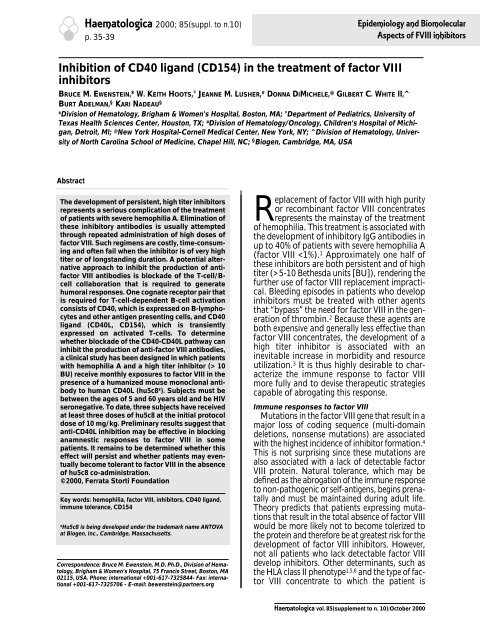Haematologica 2000;85:supplement to no. 10 - Supplements ...
Haematologica 2000;85:supplement to no. 10 - Supplements ...
Haematologica 2000;85:supplement to no. 10 - Supplements ...
Create successful ePaper yourself
Turn your PDF publications into a flip-book with our unique Google optimized e-Paper software.
<strong>Haema<strong>to</strong>logica</strong> <strong>2000</strong>; <strong>85</strong>(suppl. <strong>to</strong> n.<strong>10</strong>)<br />
p. 35-39<br />
Epidemiology and Biomolecular<br />
Aspects of FVIII inhibi<strong>to</strong>rs<br />
Inhibition of CD40 ligand (CD154) in the treatment of fac<strong>to</strong>r VIII<br />
inhibi<strong>to</strong>rs<br />
BRUCE M. EWENSTEIN,* W. KEITH HOOTS,° JEANNE M. LUSHER, # DONNA DIMICHELE, @ GILBERT C. WHITE II,^<br />
BURT ADELMAN, § KARI NADEAU §<br />
*Division of Hema<strong>to</strong>logy, Brigham & Women’s Hospital, Bos<strong>to</strong>n, MA; °Department of Pediatrics, University of<br />
Texas Health Sciences Center, Hous<strong>to</strong>n, TX; # Division of Hema<strong>to</strong>logy/Oncology, Children’s Hospital of Michigan,<br />
Detroit, MI; @ New York Hospital-Cornell Medical Center, New York, NY; ^Division of Hema<strong>to</strong>logy, University<br />
of North Carolina School of Medicine, Chapel Hill, NC; § Biogen, Cambridge, MA, USA<br />
Abstract<br />
The development of persistent, high titer inhibi<strong>to</strong>rs<br />
represents a serious complication of the treatment<br />
of patients with severe hemophilia A. Elimination of<br />
these inhibi<strong>to</strong>ry antibodies is usually attempted<br />
through repeated administration of high doses of<br />
fac<strong>to</strong>r VIII. Such regimens are costly, time-consuming<br />
and often fail when the inhibi<strong>to</strong>r is of very high<br />
titer or of longstanding duration. A potential alternative<br />
approach <strong>to</strong> inhibit the production of antifac<strong>to</strong>r<br />
VIII antibodies is blockade of the T-cell/Bcell<br />
collaboration that is required <strong>to</strong> generate<br />
humoral responses. One cognate recep<strong>to</strong>r pair that<br />
is required for T-cell-dependent B-cell activation<br />
consists of CD40, which is expressed on B-lymphocytes<br />
and other antigen presenting cells, and CD40<br />
ligand (CD40L, CD154), which is transiently<br />
expressed on activated T-cells. To determine<br />
whether blockade of the CD40-CD40L pathway can<br />
inhibit the production of anti-fac<strong>to</strong>r VIII antibodies,<br />
a clinical study has been designed in which patients<br />
with hemophilia A and a high titer inhibi<strong>to</strong>r (> <strong>10</strong><br />
BU) receive monthly exposures <strong>to</strong> fac<strong>to</strong>r VIII in the<br />
presence of a humanized mouse mo<strong>no</strong>clonal antibody<br />
<strong>to</strong> human CD40L (hu5c8*). Subjects must be<br />
between the ages of 5 and 60 years old and be HIV<br />
seronegative. To date, three subjects have received<br />
at least three doses of hu5c8 at the initial pro<strong>to</strong>col<br />
dose of <strong>10</strong> mg/kg. Preliminary results suggest that<br />
anti-CD40L inhibition may be effective in blocking<br />
anamnestic responses <strong>to</strong> fac<strong>to</strong>r VIII in some<br />
patients. It remains <strong>to</strong> be determined whether this<br />
effect will persist and whether patients may eventually<br />
become <strong>to</strong>lerant <strong>to</strong> fac<strong>to</strong>r VIII in the absence<br />
of hu5c8 co-administration.<br />
©<strong>2000</strong>, Ferrata S<strong>to</strong>rti Foundation<br />
Key words: hemophilia, fac<strong>to</strong>r VIII, inhibi<strong>to</strong>rs, CD40 ligand,<br />
immune <strong>to</strong>lerance, CD154<br />
*Hu5c8 is being developed under the trademark name ANTOVA<br />
at Biogen, Inc., Cambridge, Massachusetts.<br />
Correspondence: Bruce M. Ewenstein, M.D, Ph.D., Division of Hema<strong>to</strong>logy,<br />
Brigham & Women’s Hospital, 75 Francis Street, Bos<strong>to</strong>n, MA<br />
02115, USA. Phone: international +001-617-7325844- Fax: international<br />
+001-617-7325706 - E-mail: bewenstein@partners.org<br />
Replacement of fac<strong>to</strong>r VIII with high purity<br />
or recombinant fac<strong>to</strong>r VIII concentrates<br />
represents the mainstay of the treatment<br />
of hemophilia. This treatment is associated with<br />
the development of inhibi<strong>to</strong>ry IgG antibodies in<br />
up <strong>to</strong> 40% of patients with severe hemophilia A<br />
(fac<strong>to</strong>r VIII 5-<strong>10</strong> Bethesda units [BU]), rendering the<br />
further use of fac<strong>to</strong>r VIII replacement impractical.<br />
Bleeding episodes in patients who develop<br />
inhibi<strong>to</strong>rs must be treated with other agents<br />
that “bypass” the need for fac<strong>to</strong>r VIII in the generation<br />
of thrombin. 2 Because these agents are<br />
both expensive and generally less effective than<br />
fac<strong>to</strong>r VIII concentrates, the development of a<br />
high titer inhibi<strong>to</strong>r is associated with an<br />
inevitable increase in morbidity and resource<br />
utilization. 3 It is thus highly desirable <strong>to</strong> characterize<br />
the immune response <strong>to</strong> fac<strong>to</strong>r VIII<br />
more fully and <strong>to</strong> devise therapeutic strategies<br />
capable of abrogating this response.<br />
Immune responses <strong>to</strong> fac<strong>to</strong>r VIII<br />
Mutations in the fac<strong>to</strong>r VIII gene that result in a<br />
major loss of coding sequence (multi-domain<br />
deletions, <strong>no</strong>nsense mutations) are associated<br />
with the highest incidence of inhibi<strong>to</strong>r formation. 4<br />
This is <strong>no</strong>t surprising since these mutations are<br />
also associated with a lack of detectable fac<strong>to</strong>r<br />
VIII protein. Natural <strong>to</strong>lerance, which may be<br />
defined as the abrogation of the immune response<br />
<strong>to</strong> <strong>no</strong>n-pathogenic or self-antigens, begins prenatally<br />
and must be maintained during adult life.<br />
Theory predicts that patients expressing mutations<br />
that result in the <strong>to</strong>tal absence of fac<strong>to</strong>r VIII<br />
would be more likely <strong>no</strong>t <strong>to</strong> become <strong>to</strong>lerized <strong>to</strong><br />
the protein and therefore be at greatest risk for the<br />
development of fac<strong>to</strong>r VIII inhibi<strong>to</strong>rs. However,<br />
<strong>no</strong>t all patients who lack detectable fac<strong>to</strong>r VIII<br />
develop inhibi<strong>to</strong>rs. Other determinants, such as<br />
the HLA class II phe<strong>no</strong>type 1,5,6 and the type of fac<strong>to</strong>r<br />
VIII concentrate <strong>to</strong> which the patient is<br />
<strong>Haema<strong>to</strong>logica</strong> vol. <strong>85</strong>(<strong>supplement</strong> <strong>to</strong> n. <strong>10</strong>):Oc<strong>to</strong>ber <strong>2000</strong>
















